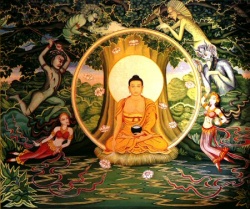Paramārtha-satya
paramārtha-satya (Sanskrit). Absolute Truth or absolute reality.
The ultimate level of Truth or reality which denotes direct experience devoid of an overlay of conceptualization, and stands in contrast to ‘relative Truth’ (saṃvṛti-satya).
Both terms are used epistemologically as well as ontologically in Mahāyāna Buddhist Thought.
མཚན་ཉིད མདོ་སྡེ་པའི་ལུགས་ལ། དོན་དམ་པར་དོན་བྱེད་ནུས་པའི་ཆོས།
a phenomenon that is ultimately able to perform a function [thus phenomena such as pots, etc. are ultimate truths in this system
Synonyms: དངོས་པོ། མི་རྟག་པ། བྱས་པ། འདུས་བྱས། རྒྱུ། འབྲས་བུ། རང་མཚན། མངོན་གྱུར། མངོན་སུམ་གྱི་སྣང་ཡུལ།
ultimate truths are understood in different ways by the various Buddhist systems; see definition heading
Comment: The Sanskrit for ultimate truth, paramārthasatya, is etymologized three ways within identifying parama as highest or ultimate, artha as object, and satya as truth.
In the first way, parama (highest, ultimate) refers to a consciousness of meditative equipoise directly realizing emptiness; artha (object) refers to the object of that consciousness, emptiness; and satya (truth) also refers to emptiness in that in direct perception emptiness appears the way it exists;
that is, there is no discrepancy between the mode of appearance and the mode of being.
In this interpretation, a paramārthasatya is a truth-that-is-an-object-of-the-highest-consciousness.
In the second way, both parama (highest, ultimate) and artha (object) refer to a consciousness of meditative equipoise directly realizing emptiness in that, in the broadest meaning of object, both objects and subjects are objects, and a consciousness of meditative equipoise directly realizing emptiness is the highest consciousness and thus highest object; satya (truth), as before, refers to emptiness.
In this second interpretation, a paramārthasatya is an emptiness that exists the way it appears to a highest consciousness, a truth-of-a-highest-object.
In the third etymology, all three parts refer to emptiness in that an emptiness is the highest (the ultimate) and is also an object and a truth, a truth-that-is-the-highest-object.
Chandrakīrti, the chief Consequentialist, favors the third etymology in his Clear Words'
ultimate truth paramaartha-satya absolute truth, ultimate truth. essence or literal meaning of the absolute truth; ultimate reality
Absolute truth (Skt. paramārthasatya; Tib. དོན་དམ་བདེན་པ་, döndam denpa; Wyl. don dam bden pa) — one of the two truths. Absolute or ultimate reality, the way things are, as distinct from the way they actually appear.
Patrul Rinpoche says:
In essence, the absolute is the basic space of phenomena (dharmadhatu), devoid of all conceptual elaboration. In its essence, it is without any divisions, but still it is possible to speak of ‘divisions’ according to whether or not this reality has been realized. Thus, there are divisions into the absolute which is the basic nature itself and the absolute which is the realization (or ‘making evident’) of this basic nature. Then again, there is the division into the absolute that is clarified through study and reflection and the absolute that is experienced through meditation practice; or the absolute that is conceptually inferred by ordinary beings versus the absolute that is experienced directly by noble beings. There is also a division into the conceptual absolute (namdrangpé döndam) and the absolute that is beyond conceptualization (namdrang mayinpé döndam).
As mentioned above, there is a twofold division of absolute truth:
Categorized (or conceptual) absolute (རྣམ་གྲངས་པའི་དོན་དམ་, namdrangpé döndam)
Uncategorized absolute (or absolute beyond conceptualization (རྣམ་གྲངས་མ་ཡིན་པའི་དོན་དམ་, namdrang mayinpé döndam)
See also Two Truths.
